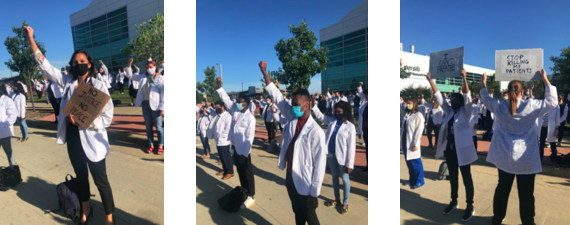From the 10/2/2020 newsletter
Perspective / Opinion
Justice Ruth Bader Ginsburg – Losing a Brilliant Voice for Equity
Libby Ellinas, MD – Director of the MCW Center for the Advancement of Women in Science and Medicine (AWSM)
Dr. Ellinas shares her perspective on the loss of Supreme Court Justice Ruth Bader Ginsburg at precisely the time when our country needs her most of all ...
Supreme Court Justice Ruth Bader Ginsburg died on September 18, 2020. It felt like a punch in the gut. A wave of loss and a fear for our nation’s future. It brought again to mind a deep concern for the health, safety, and opportunities for women in the United States.
This week, the police officer who shot and killed Breonna Taylor was not indicted. That decision brought about a wave of loss and fear for the health, safety, and opportunities for women in the United States. In the faces of my colleagues, I could see that loss, that emotion.
Justice Ginsburg’s loss was personally devastating to me, not only because she was a superb intellect and a dauntingly hard worker (two traits I admire in anyone), but because she was clever – ingenious even – at helping colleagues and justices gain insight into their own views.
There are multiple examples of RBG’s cases that support her creativity and strategy to “Fight for the things that you care about, but do it in a way that will lead others to join you.” One of my favorites is Weinberger v. Wiesenfeld, a case she litigated (as Weisenfeld’s attorney) at the Supreme Court in 1975.
Stephen Wiesenfeld and Paula Polatschek were married in 1970. Paula, the primary breadwinner, worked as a math teacher. When she died in childbirth from an amniotic fluid embolism, Steven became the sole provider for their son, subsequently applying for social security benefits. At the time, a widow under identical circumstances would have been eligible for those benefits. Steven, a widower, was not. Wiesenfeld sued for benefits, and the case was appealed all
the way to the US Supreme Court against Caspar Weinberger, the Secretary of Health, Education, and Welfare.
During the case, Attorney Ginsburg argued that the Social Security Act discriminated against both Paula’s social security contributions (because she was not a man), and Steven survivors’ benefits (because he was not a woman). The 8-0 decision rendered by eight white male Supreme Court justices agreed that the purpose of social security benefits was to allow for the proper care ofchildren, and that “proper care” was not dependent upon the sex of the parent. Arguing not for women’s rights but men’s rights, this case demonstrates Ginsburg’s ability to work within the biases of her listeners, to bring about decisions that helped erode those same biases.
Bringing us to the connection between Breonna Taylor – the individual case – and the Supreme Court. Weinberger v. Wiesenfeld was not “Weinberger v. Gender Equity.” It was brought on behalf of Steven Wiesenfeld. Father. Widower. Individual. With Ginsburg’s death, a similar case brought on behalf of Breonna Taylor won’t have the same chance, the same advocate, the same writer ofbrilliant “dissents” that RBG was notorious for. Even the likelihood that the case would be brought to the court at all is lessened without Justice Ginsburg. And that is a terrible loss.
Ginsburg’s arguments were often for equal treatment, not equitable treatment, in part because many sexist decisions were ostensibly made to “protect” women. RBG is famous for saying, “I ask no favor for my sex. All I ask of our brethren is that they take their feet off our necks.” For too many black Americans, removing pressure from a neck represents a literal first step toward justice. For many women, freeing a figurative neck is still insufficient, because many women’s feet remain firmly fixed to the floor, hemmed in by structures of racism and sexism.
As we all work to move equity forward, I believe that Justice Ginsburg would have continued to advance her thinking as well. She was open to finding her own mistakes, to being told she was wrong, to being unprotected from the truth. She said, "Women belong in all places where decisions are being made. It shouldn't be that women are the exception." But not just “present” at decisions, she furthered:
"When I'm sometimes asked 'When will there be enough [women on the Supreme Court]?' and I say 'When there are nine,' people are shocked. But there'd been nine men, and nobody's ever raised a question about that."
Once again, RBG illuminates our biases, and helps us to see that a statement that seems at first shocking, may not be so shocking after all.
We have lost a brilliant voice for justice at precisely the time when injustice needs her more than ever. It’s up to us to raise our voices now.
Elizabeth (Libby) Ellinas, MD is a Professor in the Department of Anesthesiology, Director of the Center for the Advancement of Women in Science and Medicine, and the Associate Dean of Women's Leadership at MCW. She is a member of the Faculty Pillar of the Robert D. and Patricia E. Kern Institute for the Transformation of Medicine.














